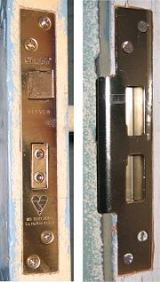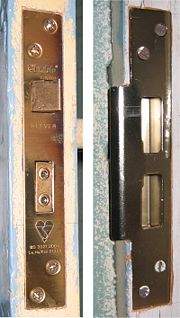
Mortise lock
Encyclopedia

Door
A door is a movable structure used to open and close off an entrance, typically consisting of a panel that swings on hinges or that slides or rotates inside of a space....
or piece of furniture
Furniture
Furniture is the mass noun for the movable objects intended to support various human activities such as seating and sleeping in beds, to hold objects at a convenient height for work using horizontal surfaces above the ground, or to store things...
into which the lock is to be fitted. In most parts of the world, mortise locks are generally found on older building
Building
In architecture, construction, engineering, real estate development and technology the word building may refer to one of the following:...
s constructed before the advent of bored cylindrical lock
Bored cylindrical lock
A bored cylindrical lock is one in which two holes are bored, perpendicular to one another, into the door. A large hole is bored into the door face and a smaller crossbore hole is bored into the door edge, as opposed to a mortise lock prep cut into the edge of the door...
s, but they have recently become more common in commercial and upmarket residential construction in the United States. They are widely used on all ages of domestic properties in the United Kingdom and Argentina.
The term “mortise” comes from the Latin root “mortuus” meaning to die because 17th century judges would sentence the harshest criminals to life in ‘mortuus obituatorium” prison cells, where the door was known to be secured by the most robust locks that were impossible for any attempts by the convicts’ friends to break him out.
The parts included in the typical mortise lock installation are the lock body (the part installed inside the mortise cut-out in the door); the lock trim (which may be selected from any number of designs of doorknobs, lever
Lever
In physics, a lever is a rigid object that is used with an appropriate fulcrum or pivot point to either multiply the mechanical force that can be applied to another object or resistance force , or multiply the distance and speed at which the opposite end of the rigid object travels.This leverage...
s, handle sets and pulls); a
strike plate
Strike plate
A strike plate is a metal plate affixed to a door jamb with a hole or holes for the bolt of the door. When the door is closed, the bolt extends into the hole in the strike plate and holds the door closed...
, or a box keep, which lines the hole in the frame into which the bolt fits; and the keyed cylinder which operates the locking/unlocking function of the lock body. However, in the United Kingdom, and most other countries, mortise locks on dwellings do not use cylinders, but have lever
Lever tumbler lock
A lever tumbler lock is a type of lock that uses a set of levers to prevent the bolt from moving in the lock. In the simplest of these, lifting the tumbler above a certain height will allow the bolt to slide past. The number of levers may vary, but is usually an odd number for a lock that can be...
mechanisms.
The installation of a mortise lock cannot generally be undertaken by the average homeowner since it is labor intensive and requires a working knowledge of basic woodworking
Woodworking
Woodworking is the process of building, making or carving something using wood.-History:Along with stone, mud, and animal parts, wood was one of the first materials worked by early humans. Microwear analysis of the Mousterian stone tools used by the Neanderthals show that many were used to work wood...
tools and methods. Many installation specialists use a mortising jig which makes precise cutting of the pocket a simple operation, but the subsequent installation of the external trim can still prove problematic if the installer is inexperienced.
Although the installation of a mortise lock actually weakens the structure of the typical timber door, it is stronger and more versatile than a bored cylindrical lock
Bored cylindrical lock
A bored cylindrical lock is one in which two holes are bored, perpendicular to one another, into the door. A large hole is bored into the door face and a smaller crossbore hole is bored into the door edge, as opposed to a mortise lock prep cut into the edge of the door...
, both in external trim, and functionality. Whereas the latter mechanism lacks the architecture
Architecture
Architecture is both the process and product of planning, designing and construction. Architectural works, in the material form of buildings, are often perceived as cultural and political symbols and as works of art...
required for ornate and solid-cast knobs and levers, the mortise lock can accommodate a heavier return spring and a more solid internal mechanism, making its use possible. Furthermore, a mortise lock typically accepts a wide range of other manufacturers' cylinders and accessories, allowing architectural conformity with lock hardware already on site.
Some of the most common manufacturers of mortise locks in the United States
United States
The United States of America is a federal constitutional republic comprising fifty states and a federal district...
are Arrow, Baldwin, Best, Corbin Russwin, Emtek, Falcon, Schlage
Schlage
Schlage is a lock manufacturer founded in 1920 by Walter Schlage in San Francisco. Schlage is one of the most popular brands of consumer and commercial locks in the United States. The company was acquired by Ingersoll Rand in 1974 and continues to be a subsidiary. Schlage also produces...
, and Sargent. Also, many Europe
Europe
Europe is, by convention, one of the world's seven continents. Comprising the westernmost peninsula of Eurasia, Europe is generally 'divided' from Asia to its east by the watershed divides of the Ural and Caucasus Mountains, the Ural River, the Caspian and Black Seas, and the waterways connecting...
an manufacturers whose products had been restricted to "designer" installations have recently gained wider acceptance and use.
Mortise Lock standards:
There are several different standards for mortice locks in use, the most common is:
British Standard (small):
Faceplate length: 152.5mm (6 inches)
Backset:44.5mm (1¾ inches)
C/C(lever lock): 57mm (2¼ inches).
C/C(bathroom mortise lock): 57mm(2¼ inches).
Used in internal doors.
British standard (large), BS3621:
Faceplate length: 176mm (7 inches).
Backset: 57mm (2¼ inches).
C/C(lever lock): 57mm (2¼ inches).
C/C(cylinder lock): 45mm (≈ 1¾ inches).
Used in entrance doors.
American standard, ANSI A156.13, ML9000-series:
Faceplate length: 203mm (8 inches).
Backset: 70mm (2¾ inches) .
Used in entrance doors.
Scandinavian standard (small), SS 817382, 20-series:
Faceplate length: 150mm.
Backset: 45mm.
C/C(lever lock): 72mm.
C/C(bathroom mortise lock): 72mm.
C/C(cylinder lock): 68mm.
Used in internal doors.
Scandinavian standard (large), SS 817383, Modular Lock:
Faceplate length: 225mm.
Backset: 50mm.
C/C(cylinder lock): 103.5mm/105mm.
C/C(lever lock): 104mm
Used in entrance doors.
German standard, DIN 18 251:
Faceplate length: 235mm.
Backset: 55mm.
C/C(lever lock): 72mm.
C/C(cylinder lock): 72mm.
C/C(bathroom mortise lock): 78mm.
Used in entrance doors and internal doors.
Italian standard:
Faceplate length: 240mm.
Backset: 35mm/40mm/50mm/55mm.
C/C(lever lock): 92mm.
C/C(cylinder lock): 88mm
C/C(bathroom mortise lock): 92mm.
Used in entrance doors and internal doors.
Older standards: These standards are no longer in use in new doors, but replacement locks are still being made.
Norwegian standard (large):
Faceplate length: 210mm.
Backset: 60mm(lever lock)/55mm(cylinder lock).
C/C(lever lock): 72mm.
C/C(cylinder lock): 95.5mm.
C/C(bathroom mortise lock): 72mm.
Norwegian standard (small), 22-series:
Faceplate length: 157mm.
Backset: 55mm.
C/C(lever lock): 72mm.
C/C(bathroom mortise lock): 72mm.
C/C(cylinder lock): 68mm.
Swedish standard (small):
Faceplate length: 215mm(earlier)/205mm(later).
Backset: 45mm.
C/C(lever lock): 72mm.
Danish standard:
Faceplate length: 230mm.
Backset: 57mm(lever lock)/60mm(cylinder lock).
C/C(lever lock): 72mm.
C/C(cylinder lock): 72mm.

